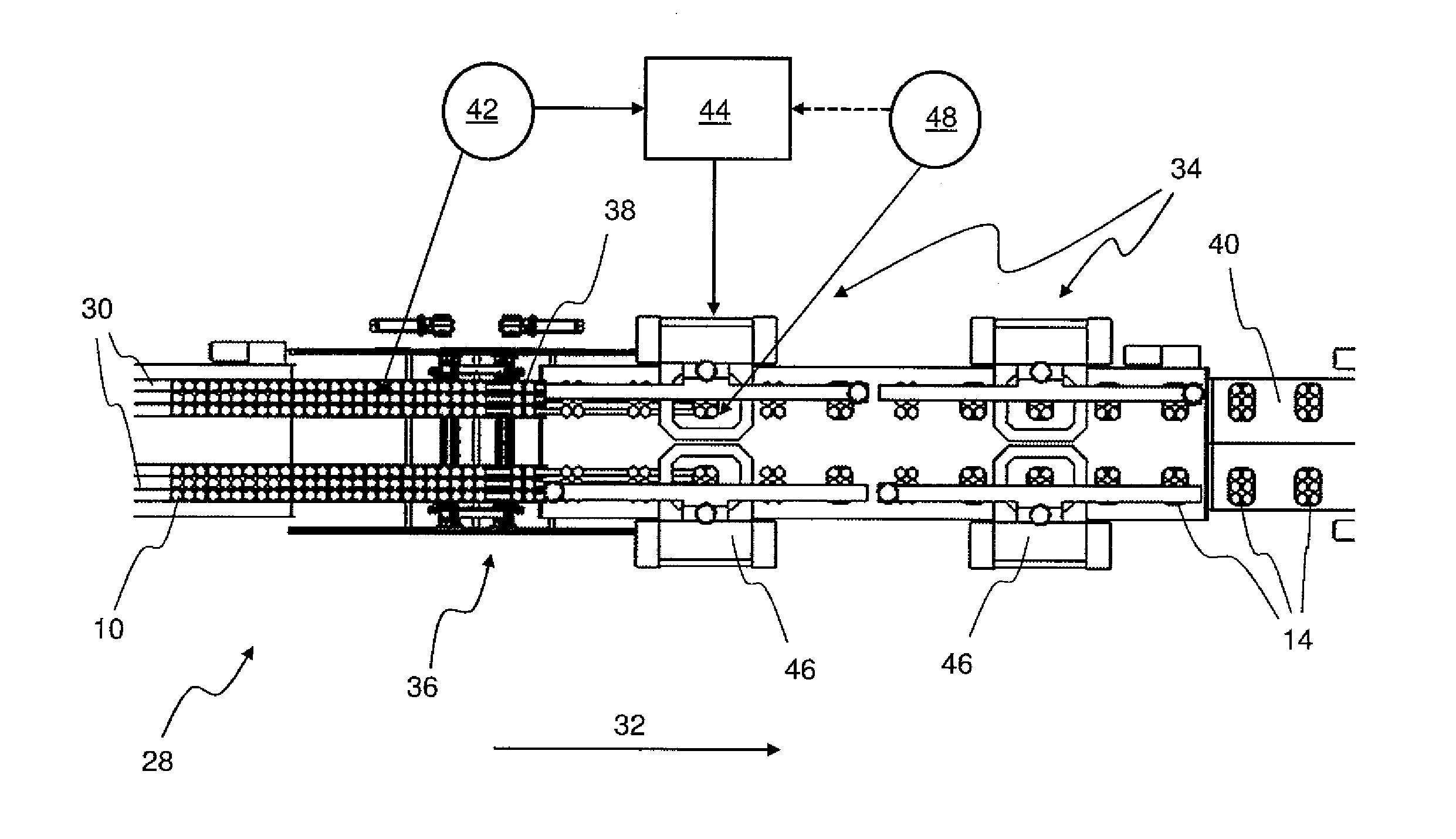Device and method for manufacturing strapped packs and regulatory and/or control method for a strapping device
- Summary
- Abstract
- Description
- Claims
- Application Information
AI Technical Summary
Benefits of technology
Problems solved by technology
Method used
Image
Examples
first embodiment
[0058]FIG. 3 shows a schematic block diagram of an embodiment of a control circuit 50 for the adjustment of the strip tension of the strapping during the ongoing process of the conveying and packaging plant 28. The adjustment is done via a respective control of the strapping heads 46 of the strapping station 34 during the application and fixation of the strapping strips 12 around the pack 14. According to FIG. 3 a first embodiment is shown, whereby the internal pressure of the containers 10 combined in packs 14 is recorded via an optical measuring means 42. The output signals 52 of the optical measuring means 42 are transferred to the control and evaluation unit 44. The control and evaluation unit 44 then generates a control signal 54 and sends it to the back tensioning means or tensioner 56, which is located in the region of the strapping head 46. Thereby the pre-stress of the strapping strips 12 is regulated and adjusted to ensure the right strip tension according to the measured ...
second embodiment
[0060]FIG. 4 shows a schematic block diagram of an alternative embodiment of a control circuit 50 for the adjustment of the strip tension of the strapping 12 during the continuing process of the conveying and packaging plant 28. The adjustment is done via a respective control of the strapping heads 46 of the strapping station 34 during the application and fixation of the strapping strips 12 around containers 10 of the pack 14. According to FIG. 4 a second embodiment is shown, whereby the deformation behavior of the containers 10 is measured via mechanical measuring means 48. Thereby the internal pressure of the containers 10 is derived indirectly. The output signals 53 generated by the mechanical measuring means 48 are transferred to the control and evaluation unit 44. The control and evaluation unit 44 then generates a control signal 54 and sends it to the back tensioning means 56 located in the region of the strapping head 46. Thereby the strip tension of the strapping strips 12 i...
third embodiment
[0066]The top view of FIG. 8 shows a mechanical measuring means with rolling sensing elements 58. The sensing elements 58 each comprise extension arms 72 with rotatable rollers 74, which can roll along the mantle surfaces 60 of the containers 10. The extension arms 72 are each movably mounted about a pivot axis 68. The extension arms 72, together with the rotatable rollers 74, are deflected outwards, when containers 10 are passing in transport direction 32. This outward deflection acts against a defined deformation force 70, which is required for introducing the desired container deformation 62.
[0067]The top view of FIG. 9 shows a further embodiment with rolling sensing elements 58. The sensing elements 58 are each formed by a pair of rollers 76 with circumferential sensing ribbons 78. The sensing ribbons 78 are unrolling on the mantle surfaces of the containers 10 on both sides. The roller pairs 76 with the sensing ribbons 78 may, for example, be movable in opposite directions towa...
PUM
 Login to View More
Login to View More Abstract
Description
Claims
Application Information
 Login to View More
Login to View More - R&D
- Intellectual Property
- Life Sciences
- Materials
- Tech Scout
- Unparalleled Data Quality
- Higher Quality Content
- 60% Fewer Hallucinations
Browse by: Latest US Patents, China's latest patents, Technical Efficacy Thesaurus, Application Domain, Technology Topic, Popular Technical Reports.
© 2025 PatSnap. All rights reserved.Legal|Privacy policy|Modern Slavery Act Transparency Statement|Sitemap|About US| Contact US: help@patsnap.com



